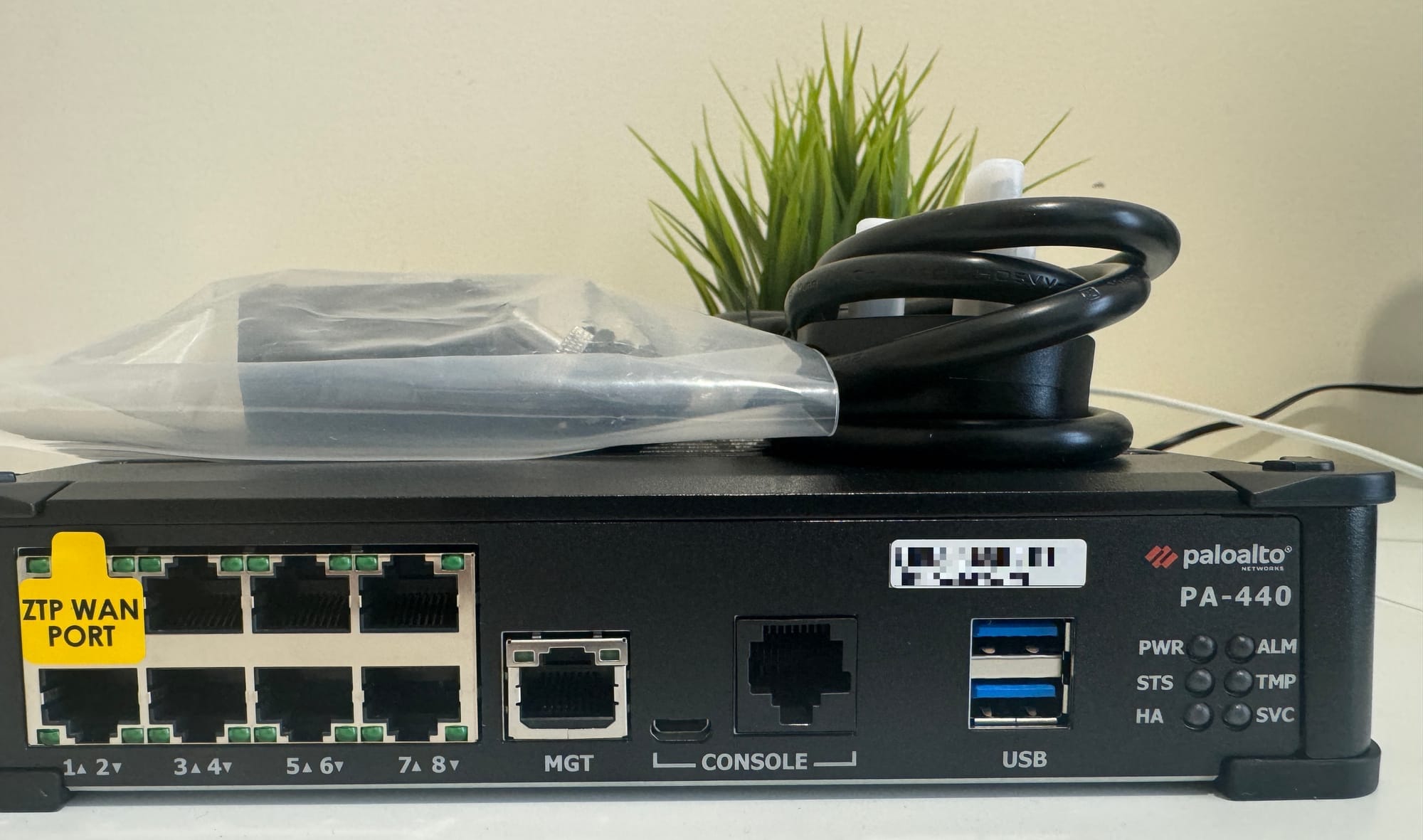Author Archives: Suresh Vina
Author Archives: Suresh Vina

I already had Palo Alto GlobalProtect VPN configured with an external gateway and portal, allowing me to connect back to my home network when I'm outside. Even when I'm inside my internal network, I can still connect to the VPN. However, I wanted to use the Internal Host Detection feature of GlobalProtect VPN, so that if I'm on my internal network and try to connect, it won't connect to the external gateway. Throughout the configurations, I learned a few lessons. Let’s dive in.
If you're completely new to GlobalProtect VPN, please check out my introductory blog post linked below.

Please note that this setup was tested on PAN-OS 10.2.9-h1 and the GlobalProtect macOS client version 6.2.4.
If you're already in your office or internal network, there's no need to connect to the VPN, what’s the point, right? This is especially relevant if you're using an Continue reading

Recently, I wanted to add a list of domains to the Palo Alto DNS policy to block them from resolving. However, I soon realized that I couldn't just add a list of domains directly to the firewall, I needed to use an External Dynamic List (EDL). Palo Alto and I believe other firewalls as well, require a simple HTTP URL that hosts a list of domains or IP addresses. While there are amazing EDL projects available, in this blog post, we'll explore the simplest way to deploy an EDL.
Python's HTTP server module lets you create a basic web server using just a single command. This server can serve files from a directory over the network, making it an excellent tool for quick testing and file sharing without the complexity of setting up a full-fledged web server.
All you need to do is create a list of domains, save it as a text file, and run python -m http.server 8085 from the directory where the file is saved. You can use any port, but remember that a lower number of ports like 80 require admin privileges. Once the server is running, navigate to http://IP_ADDRESS:8085/domains.txt in Continue reading

As soon as you configure GlobalProtect and go to the monitor tab, you will see hundreds or even thousands of attempts on your firewall's public IP on port 443. While protecting your portal with MFA generally mitigates major concerns, it’s still wise to implement as many security measures as possible. In this blog post, we will look at some simple ways to protect your GlobalProtect deployment.
We will look at the following methods.
Before we proceed, just a quick note on how Intrazone policy works. By default, the firewall comes with two predefined security rules at the very bottom. The Interzone rule denies traffic between two zones that are not matched by a specific policy above.

However, the default intrazone action is to allow, so traffic within the same zone is allowed by default. If someone initiates traffic from the WAN zone to Palo Alto’s public interface in Continue reading

I've tried many note-taking apps like Evernote, OneNote, and Apple Notes, but none really satisfied me, if I'm being honest. I've always wanted something simple, without any over-complication, and either free or cost-effective. Although, I have to admit, at the moment, I'm using an app called 'Bear Notes,' which costs around £2 per month, and I love the app. It's so minimalist and very user-friendly, but it doesn't have a web GUI or an app for Windows. I'm an Apple user, so it's not a big issue.
That being said, I recently stumbled upon another great self-hosted note-taking app called 'Memos' I just couldn't believe that I didn't know about this until very recently. It's so minimalist and has a Twitter-like feed where you can just chuck on any note, links, or even attachments.

If you already have Docker installed, the installation will take just a few seconds. You can use either docker run or docker-compose.
docker run -d \
--init \
--name memos \
--publish 5230:5230 \
--volume ~/.memos/:/var/opt/memos \
neosmemo/memos:stableservices:
memos:
image: neosmemo/memos:stable
container_name: memos
volumes:
- ~/.memos/:/var/opt/memos
ports:
- 5230:5230In the Docker configuration for Continue reading

In this blog post, we're going to explore how to Auto-Scale Palo Alto VM-Series Firewalls in AWS. It's a known fact that running heavy instances in AWS can be costly, and it's not wise to have more firewalls running than necessary. But what happens when demand spikes unexpectedly? If we're not prepared, things can get messy quickly.
Auto-scaling these firewalls isn't as simple as pressing a button. There are several components to consider, but don't worry - once you grasp the basics, it's as straightforward as any other topic in the cloud and network world.
This blog post is based on the ideas from the Palo Alto Github repo - https://github.com/PaloAltoNetworks/terraform-aws-vmseries-modules/tree/main/examples/centralized_design_autoscale
As we get into the specifics of auto-scaling Palo Alto VM-Series firewalls in AWS, there are a few assumptions I'd like to lay out. This Continue reading

When I started my home lab, I used a Raspberry Pi 4 that functioned as a router/firewall, and I was pretty happy with it. Then, I needed something solid and cost-effective. There were multiple options like VyOS, PfSense, UniFi, etc, but MikroTik, specifically the hAP ax2, stood out for me. I've been using this for almost a year now, and I absolutely love it. It works as a switch, and firewall and runs my WireGuard VPN, and it has never let me down even once.
Fast forward to today, I started adding more and more devices to the lab, so I was looking for an upgrade. After debating between FortiGate and Palo Alto, I finally settled on buying a Palo Alto PA-440 firewall.

But I would say the main reason behind this decision is that I write a lot of content on Palo Alto, and not having a dedicated device was such a pain. Every time I wanted to write a post, I had to start the lab, and try things out, and not having licenses was preventing me from trying new features and sharing them via a post. Now, with a dedicated unit and Continue reading

If you rely heavily on Palo Alto App-IDs, you know the challenge of managing new and modified App-IDs. Palo Alto regularly updates its App-ID database, introducing new App-IDs every month (typically on the third Tuesday) and modifying existing ones more often.
Each release can include hundreds of new and updated App-IDs. It's almost impossible to understand each of them and decide whether or not we are affected by the change. In this blog post, we will look at using Threat Signature Indicators (TSID) to help you get an advanced indication of any impact on your traffic as a result of upcoming App-ID changes.
Let’s imagine for a moment that currently, Palo Alto doesn’t have a specific App-ID for ‘chatgpt’ (although they do, let’s assume they don’t for this example). If there isn’t an App-ID, the traffic would be identified as ‘ssl’. If Palo Alto decides to introduce a new App-ID for ‘chatgpt’, they will announce this in the new App-ID release notes. However, the challenge is that hundreds of other new App-IDs could be introduced at the same time that we might never have heard of.
So, when I go to Continue reading

XtendISE is a simple web application connected to your Cisco ISE, which helps with everyday routine tasks and common challenges related to 802.1X without the need to train everyone in Cisco ISE. XtendISE can help you manage MAC addresses and troubleshoot 802.1X authentications. It also helps with managing the switch's 802.1x configuration or validating the configurations to make sure that they are configured as intended.
All the mentioned features save time for us Network Engineers and help us to do our job efficiently as we do not waste our time on routine tasks. It also increases network security because it makes sure that our network is configured correctly and thus is safe and secured.
XtendISE is suitable for a company of any size with Cisco ISE and Cisco network devices. However medium or large companies will better use XtendISE features because they are more likely affected by the mentioned problems.
XtendISE helps the Helpdesk or IT Support with

If you've ever worked with traditional Layer 4 firewalls, you might be familiar with configuring security policies based on TCP or UDP port numbers. For instance, to allow DNS, you'd create a policy for UDP/53, or for LDAP, a policy for TCP/389.
This approach is normal with firewalls like Cisco ASA. But it's 2024, and Next-Generation Firewalls (NGFWs) have become the standard, offering a more sophisticated way to manage security. Instead of relying solely on port numbers, NGFWs like those from Palo Alto Networks encourage defining security policies based on the actual applications termed 'App-ID'. For example, instead of specifying port numbers, a policy could simply be defined to allow 'DNS' and 'LDAP', focusing on the applications themselves.
Okay, that sounds simple, so why continue reading you may ask? Well, while Palo Alto’s App-ID does work well most of the time, there are nuances that you need to understand. For applications like DNS, NTP, and LDAP, App-ID works very well. However, the most common applications involve SSL or web browsing, typically associated with ports 80 and 443.
Palo Alto provides App-IDs for both SSL and Web-Browsing (called ssl and web-browsing Continue reading

I think this is going to be the shortest blog post of all time because running a Python HTTP server is incredibly straightforward. Python's HTTP server module lets you create a basic web server using just a single command. This server can serve files from a directory over the network, making it an excellent tool for quick testing and file sharing without the complexity of setting up a full-fledged web server.
You can start the Python HTTP server with the command python -m http.server 8000, which serves files from the current directory on port 8000. You can choose any port number by replacing 8000 with your preferred port. However, if you select a lower port number, such as 80, you might need administrator privileges to run the server.
In this example, I have two files in a directory - one is a text file with a list of domains and the second is a simple YAML file.

If I run the command python -m http.server 8000, it starts a web server and I Continue reading

A few years ago, I used a simple application called 'TypeItIn'. It kept a small GUI window open with some buttons and labels. You could configure each label with your own text. If you wanted to type one of these texts into a window, all you needed to do was click on the label, and it would start typing the text into whatever window you opened. It was such a time-saver, especially if you had multiple texts that you often used.
Fast forward a few years, I really needed such a tool and then realized I knew a bit of Python, so I should be able to create the same functionality using Python. So, in this blog post, let's go through how you can create a simple GUI application with just a few lines of code.
Tkinter is the standard GUI toolkit for Python, providing a fast and easy way to create simple GUI applications. It is built into Python, so there’s no need to install anything separately if you already have Python.
Tkinter is widely used due to its simplicity and the vast availability of widgets like buttons, menus, and text fields, which help Continue reading

I know what you're thinking, we usually manage our Python code via Git to track changes, but what do I mean by using GitPython to manage Git repositories? I recently faced a situation where I needed to automate a Git workflow. This includes pulling the latest changes from a Git repository, creating a branch, making some changes, viewing the diff, committing, and then pushing my branch back to the remote repository.
Doing this repeatedly was time-consuming, and I figured there must be a way to automate this. With Python, virtually anything is possible. I found a Python library called 'GitPython' that does exactly this. So, let's get to it.
GitPython is a Python library that lets you work with Git repositories. It allows you to manage Git tasks using Python code, making it easy to automate things like commits, branches, and pushes without using the command line. This is useful for automating repetitive Git tasks directly from Python.
For example, you can use it to pull the latest updates from a repository, create new branches, and commit to your changes. It also provides a way to view diffs, so you can see what has changed Continue reading

In the previous pipelines, I’ve been using Python and had to install multiple pip modules. Suppose we have 5 different jobs, we would be installing the pip modules again and again for each job, which takes a while to complete. Remember, each job runs in its own pristine environment, meaning it builds a fresh Docker container and installs all the required modules before running the script we need. This repetition can slow down the pipeline significantly.
In this blog post, let’s look at how you can use GitLab Cache to speed up your jobs and avoid unnecessary reinstallations. If you are new to GitLab or CI/CD in general, I highly recommend checking out my previous GitLab introduction post below.

This is how my pipeline looked before. Though it worked perfectly fine, it took around 45 seconds to run each job and just over 3 minutes for the entire pipeline to Continue reading

We all know that by default, all the devices in the same VLAN can talk to each other. For example, if you have a switch with multiple devices connected to it and if they are part of the same VLAN, they can communicate without any restrictions. But there are times when you might want to keep the devices in the same VLAN while preventing them from talking to each other. This is where Private VLANs come into play, offering control over who can talk to each other within the 'same VLAN'. So, let’s get started and we will cover the following topics.
Let's break down how Private VLANs work with a simple scenario. Imagine we have a "users" VLAN where all the laptops connect. Suppose we have a mix of Windows and Linux devices. We want to ensure that Windows devices can't communicate with each other at all. However, it's okay for Linux devices to talk to each other, but they shouldn't communicate with the Windows devices either.

Hi all, welcome back to part 4 of the Network CI/CD blog series. So far, we've covered the purpose of a Network CI/CD pipeline, the problems it solves for Network Engineers, and how to set up GitLab, including creating projects, installing runners, and understanding GitLab executors. We also looked at how to use GitLab variables to securely hide secrets.
In this part, we'll explore how to manage a campus network using Nornir and Napalm and deploy configurations through a CI/CD pipeline. Let's get to it!

As I mentioned previously, I'm not a CI/CD expert at all and I'm still learning. The reason for creating this series is to share what I learn with the community. The pipeline we are building is far from perfect, but that's okay. The goal here is to create a simple pipeline that works and then build upon it as we go. This way, you can start small and gradually Continue reading

Hi all, welcome back to our Network CI/CD blog series. In the previous posts, we covered what CI/CD is and why you need it for Network Automation. We also covered GitLab basics and how to set up your first pipeline. In this post, we’ll look into how to keep your credentials secure by hiding them from the repository and using GitLab variables. Let’s get to it!
In GitLab CI/CD, variables play an important role in managing dynamic values throughout your pipeline. These variables can store anything from environment-specific settings to sensitive information like credentials. By using variables, you can easily manage and change values without hardcoding them in your scripts or playbooks.
GitLab provides a secure way to store sensitive data such as passwords or API tokens. You can define these variables in your project’s Settings > CI/CD > Variables section, and they will be securely injected into your pipeline during runtime.

If you recall, in our previous examples, we had the username and password hardcoded in the Ansible variables file. This is not secure at all, and you should never expose sensitive information like credentials directly in your repository. By using GitLab variables, you can securely Continue reading

Netpicker is a tool that brings together config backups, security/compliance checks, and automation in one place. Netpicker supports 130+ network vendors, including Cisco, Juniper, Arista, Palo Alto, and Fortinet. It also integrates well with tools like Netbox, Nautobot, and Infrahub for inventory, and Slurp’it for network discovery. You can also reuse your existing Python scripts to run checks or automate tasks across your network.
In this post, we'll go through how to set up Netpicker and configure device backups for free. We'll also look at how Netpicker stores these backups and how you can compare or view the diff to see what has changed over time.
Please note that this is a paid article. Netpicker has asked me to write and publish this blog post on their behalf, and I’ve charged a fee for it. As of writing this, Netpicker also sponsors my blog.
To get started, head over to the Netpicker website and fill out the form with your name and email. You’ll receive an email shortly with the download instructions. Netpicker comes with a free-for-life license that gives you unlimited device backups and basic automation. You’ll also get a ‘Professional’ license Continue reading

I just realized how much I didn't know about Python Object-Oriented Programming. I thought I knew the basics, but a few days ago, while going through a Python course, I found out I was wrong. Before I forget what I’ve learned, I wanted to write this blog post and share it with you.
In this blog post, we’ll cover the difference between functions and methods, and what exactly ‘self’ means in Python. So, let’s get to it.
class MyClass:
def say_hello():
print('Hello')In this snippet, we’ve defined a Class called MyClass with a function named say_hello. But here’s a question for you - what do you call say_hello? Is it a function or a method?
It’s a common misconception to think that simply defining a function inside a Class automatically makes it a method. However, the distinction lies in how the function is accessed.


Hi all, welcome back to the Packetswitch blog. In today's post, we'll explore how to use NAPALM for managing device configurations. We'll focus on Arista EOS as our example. We'll cover the methods available in NAPALM and how to push, commit and revert configurations on Arista devices.
We'll start by explaining what NAPALM is and why you might want to use it. Then we'll move on to a few examples and take a look at what happens behind the scenes. This approach will give you a clear understanding of NAPALM's role in network configuration management and how it works with Arista EOS devices.
NAPALM stands for Network Automation and Programmability Abstraction Layer with Multivendor support. It's a Python library that helps network engineers manage and automate different network devices using a common set of functions. NAPALM solves the problem of dealing with multiple vendor-specific interfaces by providing a unified way to interact with network devices from various manufacturers. This means you can use the same code to manage devices from Cisco, Juniper, Arista, and others, saving time and reducing the complexity of network automation tasks.

Hi all, welcome back to our Network CI/CD blog series. In this part, we’ll discuss what exactly GitLab is and the role it plays in the whole CI/CD process. We’ll explore how to use GitLab as a Git repository, how to install GitLab runners, and how to write a GitLab CI/CD pipeline, among other topics. So let’s get to it.
Before we proceed, let’s go over some prerequisites. This part of the series assumes you have some familiarity with Git, Ansible, and basic Docker concepts. I’m not an expert in any of these, but I have a basic understanding of what each tool does and how to configure and use them. Even if you’re not very familiar, you can still follow along as we go step by step.
Git is a version control system that allows you to track changes to your code, collaborate with others, and manage different versions of your projects. It's a fundamental tool for network automation that works with code or configuration files.